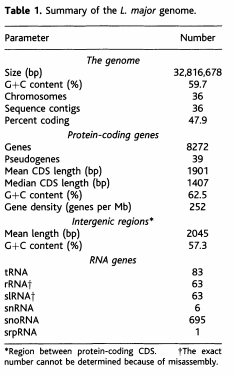Lena Week 11
Contents |
The Genome of the Kinetoplastid Parasite, Leishmania major.
Vocabulary
1.)promastigote: the flagellate stage of a trypanosomatid protozoan, as that of any of the Leishmania parasites.
2.)amastigote: the nonflagellate, intracellular, morphologic stage in the development of certain hemoflagellates, resembling the typical adult form of Leishmania.
3.)phagolysome:a cellular body that is formed by the union of a phagosome or ingested particle with a lysosome that contains hydrolytic enzymes.
4.)macrophage: any of the large, mononuclear, highly phagocytic cells derived from bone marrow cells, promonocytes, the progeny of which, the monocytes, enter the bloodstream, where they stay for a few days before entering the tissues and developing into macrophages. They are components of the monocyte-macrophage system. Macrophages are usually immobile but become actively mobile when stimulated by inflammation, immune cytokines and microbial products. They are an important class of antigen presenting cells (APCs).
5.)glycoconjugate: any of the complex molecules containing glycosidic linkages, such as glycolipids, glycopeptides, oligosaccharides, or glycosaminoglycans.
6.)aneuploid: Having a chromosome number that is not a multiple of the haploid number for the species.
7.)pseudogene:a defective segment of DNA that resembles a gene but cannot be transcribed.
8.)ortholog: any gene found in two or more species that can be traced to a common ancestor; specif. one of two homologous genes that is descended from a common ancestor, but which has evolved in a different way.
9.)synteny: the presence of two or more genes on the same chromosome.
10.)trypanosome: any minute, flagellate protozoan of the genus Trypanosoma, parasitic in the blood or tissues of humans and other vertebrates, usually transmitted by insects, often causing serious diseases, as African sleeping sickness in humans, and many diseases in domestic animals.
11.)proteolytic: the breaking down of proteins into simpler compounds, as in digestion.
Significance
Leishmania is a pathogenic parasite that causes range a diseases in humans--these maladies are collectively termed the leishmaniases. This paper looked at the genome of Leishmania major, paying particular attention to molecular processes. Synthesis of complex surfaces glycoconjugates, an essential aspect of host-parasite interaction in the Leishmania species was examined in depth.
Methods
The researchers used shot-gun sequencing. Shot gun sequencing breaks up DNA into many fragments, then sequences them into what are called reads. A researcher would perform this several times to get many reads, then a computer uses the overlapping ends of reads to generate a full and continuous sequence. In this project, large-insert clones and purified chromosomal DNA were shotgun sequenced. This allowed them to generate a full sequence for each of Leishmania's 36 chromosomes. The sequences were then compared to an optical map to ensure accuracy. Additionally, the Leishmania genome was analysis with the help of algorithms to predict numbers of RNA genes, pseudogenes, and protein-coding genes.
Results and Discussions
Algorithms predict Leishmania species to have 911 RNA genes, 39 pseudogenes, and 8272 protein-coding genes. Thirty-six percent of these genes are thought to have a function. 3083 of Leishmania's genes form 662 putative related-gene families. Small gene families (fewer than 10 members) are thought to have arisen from tandem gene duplication. Larger gene families have multuple loci that code for single genes and/or tandem arrays. Below is Table 1 from the paper, which summarized the Leishmania genome.
